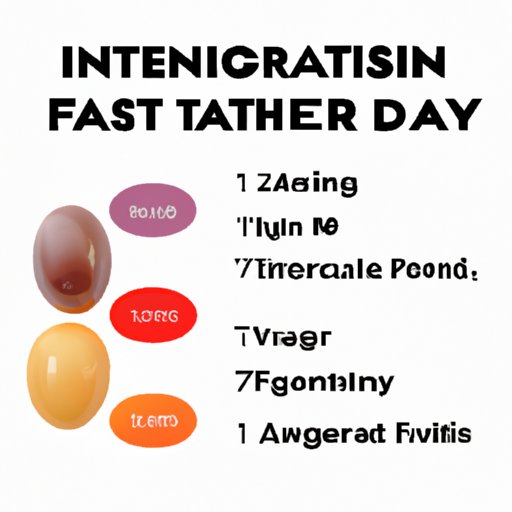
I. Introduction
Intermittent fasting has become a popular weight-loss method in recent years. It is not only a way to shed pounds but also has many potential health benefits. This article aims to explain what intermittent fasting is, how it works for weight loss, and how much weight you can lose with it.
II. Different types of intermittent fasting
There are various methods of intermittent fasting, each with its own rules and benefits. The most commonly practiced ones are:
A. 16/8 Method: This is also known as the Leangains method. It involves a daily eating window of 8 hours and fasting for the remaining 16 hours. It can be done every day or a few times a week.
B. 5:2: This method involves eating normally for five days of the week and restricting calorie intake to 500-600 calories for the other two days.
C. Alternate-day fasting: Fasting every other day is known as alternate-day fasting. On fast days, no or very few calories are consumed, while on non-fasting days, normal eating resumes.
D. One meal a day: As the name suggests, this involves eating one meal a day while fasting for the remaining hours.
Each of these methods has proven to be effective in weight loss and has different health benefits.
III. Recent studies on intermittent fasting and weight loss
Several recent studies have examined the effectiveness of intermittent fasting for weight loss. A 2014 review study showed that intermittent fasting done for a period of 3-12 weeks led to significant weight loss and a decrease in body fat. A more recent study from 2019 found that fasting for 16 hours a day led to a reduction in calorie intake and weight loss in obese adults.
Intermittent fasting has also been found to have other health benefits, such as reducing inflammation, improving blood sugar levels, and lowering the risk of heart disease.
IV. How intermittent fasting works for weight loss
Intermittent fasting works for weight loss by impacting metabolism, hormones, and appetite. When the body is in a fasted state, it uses stored fat for energy, leading to weight loss.
A. Impact on metabolism: Intermittent fasting leads to an increase in the body’s metabolic rate, allowing it to burn more calories than usual.
B. Impact on hormones: Fasting triggers the release of several hormones, such as growth hormone and adrenaline, which aid in weight loss by increasing fat burning.
C. Impact on appetite: When you fast, the levels of the hunger hormone ghrelin decrease, leading to a decrease in appetite and calorie intake.
Intermittent fasting works for weight loss because it creates a calorie deficit without requiring you to restrict yourself from certain foods.
V. Real-life stories of people who have lost weight with intermittent fasting
Many people have had success with intermittent fasting as a weight loss technique. Some examples include:
A. Sarah: Sarah followed the 16/8 method and lost 30 pounds in six months.
B. John: John followed the 5:2 method and lost 15 pounds in twelve weeks.
C. Ana: Ana did alternate-day fasting and lost 25 pounds in five months.
All these individuals had different methods, but intermittent fasting was the key factor in their weight loss.
VI. Expert tips and recommendations for intermittent fasting
Before starting intermittent fasting for weight loss, it is crucial to know how to do it correctly to get the desired results. Here are some expert tips:
A. How to start: Start with a simple fasting plan that suits your lifestyle. Be consistent but flexible with the fasting schedule and gradually increase the duration of fasting.
B. What foods to eat: Eat nutrient-rich, whole foods which will keep you fuller for longer. Avoid processed and junk foods. Drink plenty of water.
C. When to exercise: Exercise is best done during the fasted state to maximize the benefits of intermittent fasting for weight loss.
D. Other helpful suggestions: Get enough sleep, manage stress levels, and consult your doctor before starting intermittent fasting if you have any underlying health conditions.
VII. Potential drawbacks and side effects of intermittent fasting
Intermittent fasting is generally considered safe, but it may not be suitable for everyone. Some potential risks and side effects include:
A. Hunger: Some people may find it challenging to stick to the fasting schedule, leading to hunger and overeating.
B. Dehydration: Not drinking enough water during fasting can lead to dehydration and other complications.
C. Low blood sugar: People with diabetes or low blood sugar levels should consult their doctor before starting intermittent fasting.
It’s essential to mitigate these risks and side effects by listening to your body and consulting your doctor before starting intermittent fasting.
VIII. Conclusion
Intermittent fasting is a promising weight-loss method that has helped many people achieve their weight loss goals. By following the recommended fasting schedules, eating whole, nutrient-dense foods, and exercising in the fasted state, you could see positive results in your weight, health, and overall well-being. However, intermittent fasting may not be suitable for everyone. You should consider the potential risks and side effects and consult your doctor before beginning any new diet or exercise regimen. Remember, intermittent fasting is just one of many options for weight loss, so stay open to alternatives and find the perfect plan that works for you.




